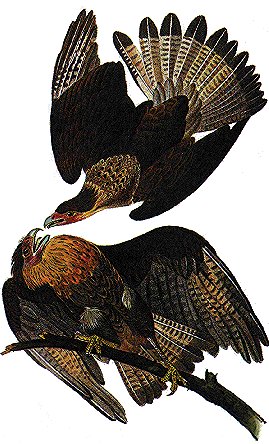- Guadalupe Caracara
Taxobox
name = Guadalupe Caracara
status = EX
status_system = iucn3.1
extinct = 1900 or 1903

image_width = 200px
regnum =Animal ia
phylum =Chordata
classis =Aves
subclassis =Neornithes
ordo =Falconiformes
familia =Falconidae
subfamilia =Polyborinae
genus = "Caracara"
species = "C. lutosa"
binomial = "Caracara lutosa"
binomial_authority = (Ridgway, 1876)
synonyms ="Polyborus plancus lutosus"
"Caracara plancus lutosus"
"Polyborus lutosus"The Guadalupe Caracara, "Caracara lutosa" or "lotusos", is an extinct
bird of prey belonging to thefalcon family (Falconidae). It was, together with the closely related Crested andSouthern Caracara , formerly placed in the genus "Polyborus". It was also known as the Quelili or the Calalie.This
species inhabitedMexico 'sGuadalupe Island until the beginning of the 20th century. TheCrested Caracara is sometimes incorrectly referred to as "Guadalupe Caracara", because the extinct birds were formerly considered asubspecies of the extanttaxon . They were reinstated as a full species in 2000. [AOU (2000)]It was described as "evil" and "vicious" by early observers. It was driven to extinction by a hunting and poisoning campaign led by goatherders on Guadalupe Island. In 1876 the species was common throughout the island. However, in March 1897, only one bird was encountered, [Kaeding (1905)] but additional members of the species survived. On
December 1 ,1900 collectorRollo Beck encountered 11 and preserved nine as scientific specimens. He may have shot the last of the caracaras on Gaudalupe Island, believing from their fearlessness and ease of finding them that they were common. [Abbott 1935] There was one more (unconfirmed) sighting in 1903Fact|date=February 2007; the bird was certainly gone in 1906. [Thayer & Bangs (1908)] The Guadalupe Caracara is one of the few species that were intentionally rendered extinct by humans. In its particular case, it was demanded by goat farmers that the birds were to be killed off as they occasionally fed on young goats (though the role of the caracara as a predator of goats was much exaggerated). cite book| last = Ellis| first = Richard| authorlink = Richard Ellis (biologist) | title = No Turning Back: The Life and Death of Animal Species| publisher = Harper Perennial | date = 2004| location = New York| pages = 172| isbn =0-06-055804-0 ] It stands to note that its erstwhile home was at that time being devastated by tens of thousands of goats gone feral, leading to the extinction of several endemic species caused by the near-total destruction of habitat. [León de la Luz "et al." (2003)]In an apparent case of
coextinction , theischnocera nlouse "Acutifrons caracarensis " is only known from the Guadalupe Caracara. [Mey (1990)]Around 35 specimens (skins, skeletons and 2 eggs) remain in public collections today. [Luther (1996)] Specimens are available for display in
Chicago ,Washington , andLondon .Footnotes
References
* 1933. Closing history of the Guadalupe Caracara. Condor 35:10-15.
* (2000): Forty-second supplement to the American Ornithologists' Union Check-list of North American Birds. "Auk" 117(3): 847–858. DOI: 10.1642/0004-8038(2000)117 [0847:FSSTTA] 2.0.CO;2
*|year=2004|id=40678|title=Caracara lutosa|downloaded=19 October 2007
* (2000): "Extinct Birds" (2nd ed.). Oxford University Press, Oxford, New York. ISBN 0-19-850837-9
* (1967): Guadelupe Island Carcara. "In: Extinct and Vanishing Birds of the World" (2nd ed.): 183-195. Dover Publications, New York.
* (1905): Birds from the West Coast of Lower California and Adjacent Islands (Part II). "Condor" 7(4): 134-138. [http://elibrary.unm.edu/sora/Condor/files/issues/v007n05/p0134-p0138.pdf PDF fulltext]
* (1981): "Endangered Birds of the World; The ICBP Bird Red Data Book": Preamble 8. ISBN 0-87474-584-5
* (2003): On the urgency of conservation on Guadalupe Island, Mexico: is it a lost paradise? "Biodiversity and Conservation" 12(5): 1073–1082. doi|10.1023/A:1022854211166 (HTML abstract)
* (1996): "Die ausgestorbenen Vögel der Welt (Die neue Brehm-Bücherei 424)" (4th ed.). [in German] Westarp-Wissenschaften, Magdeburg; Spektrum, Heidelberg. ISBN 3-89432-213-6
* (1990): Eine neue ausgestorbene Vogel-Ischnozere von Neuseeland, "Huiacola extinctus" (Insecta, Phthiraptera). "Zoologischer Anzeiger" 224(1/2): 49-73. [German with English abstract] [http://www.phthiraptera.org/Publications/0472.pdf PDF fulltext]
* (1908): The Present State of the Ornis of Guadaloupe Island. "Condor" 10(3): 101-106. doi|10.2307/1360977 [http://elibrary.unm.edu/sora/Condor/files/issues/v010n03/p0101-p0106.pdf PDF fulltext]
Wikimedia Foundation. 2010.
